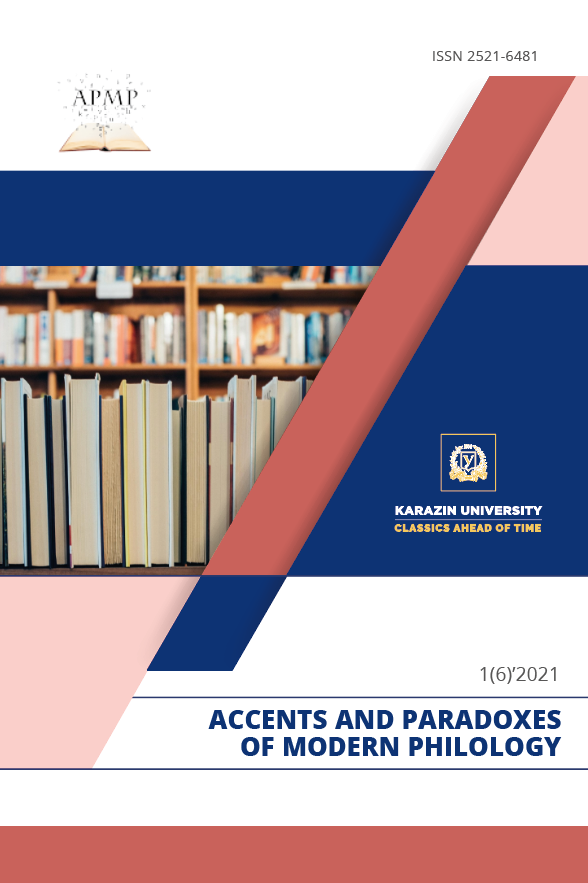TRICKSTER ARCHETYPE IN MODERN MEDIA CULTURE: SHOWIZATION AND DEMONISM
Abstract
The paper is devoted to the study of the Trickster archetype in modern media culture. The attention is focused on certain literary texts – the literary heritage of the world (“The Golden House” by S. Rushdie) and Ukraine (“The Black Raven” by V. Shkliar), movies (“Joker” (2019) by Todd Phillips), the personalities of political elite (Donald Trump, V. Zelensky, Prankster Joker, etc.) and others, who made the Trickster archetype one of the key archetypes in the modern world and Ukrainian media space as well as in everyday life. For instance, in Shkliar’s novel “The Outcast. The Black Raven” – the postcolonial embodiment of the national collective unconscious injured by the traumatic Russian expansion, the role of Trickster belongs to the Black Raven – the rebel commander, defender of the Kholodnyi Yar (Cold Ravine). In another novel, “The Golden House” by S. Rushdie, Trickster is represented by twin heroes, tycoon Nero Golden and the Joker. The latter one ran for the US presidency and took office. The poetics of the composition fits into the Gothic novel scheme. Both characters are Gothic thieves demonstrating the “shadow” side of the Trickster archetype. The image of the Joker here is closely connected with American reality by means of movie and show format, where the function of the Trickster archetype is assigned to US President Donald Trump, whose image is also being demonized. In Ukraine, the role of Trickster is assumed by the President of Ukraine Volodymyr Zelensky – a comedian and showman accompanied by his colleagues from the “Studio Quarter – 95”. The atmosphere of the show deals with national politics, life and media space. The negation of the new government is reflected in Prankster Joker’s grim jokes over deputies. The global trends towards escalating infernal power of the Trickster archetype, related to the absurd motives,
the sinister carnival and the madness, are expressed in the movie “Joker” (2019), with its main character Arthur Fleck as a Trickster as well.
Therefore, in modern media space the interpenetration of the semiotic codes of the media, the Internet, culture and real life can be observed. The personality perceives and reproduces these signs. The Trickster archetype has become a mega media image in the collective unconscious. It brought in focus the motives of the show and the game, acquired demonic traits against the background of social dehumanization and socio-political problems.
Downloads
References
Ankhimova, R. (2015). Psychological features of mass media influence over the personality. International journal of experimental studies, № 3 (3). Pp.359 ―365. Retrieved from: https://www.expeducation.ru/ru/article/view?id=7154 (in rus)
BBC. News. Russian Service (2017). End of American dream? Salman Rushdie on his new novel. Retrieved from: https://www.bbc.com/russian/features-41530094. (in rus)
Bryant, Jennings, Thompson, Susan (2004). Fundamentals of Media Effects. Мoscow: Publishing house “Williams”, 432 p. (in rus)
The crow. Myths of the peoples of the world (1991). Encyclopedia in 2 volumes. Edited by S.А. Tokarev. М. Soviet encyclopedia. Vol.1. А― К. 671 p. (in rus)
Zborovska, N. (2006). The code of Ukrainian literature: the project of psycho-history of modern Ukrainian literature. Кyiv: Akademvydav,. 498 p. (in ukr)
Kyiv International Institute of Sociology (KIIS) (2020). Retrieved from: https://kiis.com.ua/?lang=ukr&cat=reports (in ukr)
Parimatch (2019). Retrieved from: https://social.bet/blog/bonus-3-000-rublej-ot-parimatch-na-premiyu-oskar/ (in rus)
Rushdie, S. (2019). The Golden House: novel. Lviv : Vydavnytstvo Starogo Leva. 496 p. (in ukr)
The Telegraph. News. Ukraine and world. Are you ready? A new epic story of insolent Conor McGregor (2019). Retrieved from : https://telegraf.com.ua/sport-cat/drugie-vidyi/5224969-ot-dzhokera-do-korolya-ringa-makgregor-snyalsya-v-novoy-reklamnoy-kampanii-video.html. (in rus)
Chernyakhovskaya, Y. V. (2004). Trickster or a journey into chaos. Chelovek, №3. 37 52 p. (in rus)
Denys Chyk, Olga Chyk (2017). “Who has ever deceived the moskal?” : the poem of “The Aeneid” by I. Kotliarevskyi in the context of the picaresque literature. Synopsis: text, context, media, No 3 (19), Borys Grinchenko Kyiv University. Retrieved from: https://synopsis.kubg.edu.ua/index.php/synopsis/article/view/264. (in ukr)
Jung, C.G. (1996). Soul and myth: six archetypes. Кyiv: State library of Ukraine for youth. 384 p. (in rus)
Fertel, R. Trickster (2018). His Apocalyptic Brother, and a World’s Unmaking: An Archetypal Reading of Donald Trump / from Jung's Red Book for Our Time: Searching for Soul Under Postmodern Conditions Volume 2, eds., Murray Stein and Thomas Arzt, Chiron Publications Retrieved from: https://papers.ssrn.com/sol3/papers.cfm?abstract_id=3212749.
Gerbner, G., Gross, L., Morgan, M., Signorielli, N. & Shanahan, J. (In press). Growing up with television: Cultivation processes. In Jеnning Bryant & Dolf. Zillmann (Eds.), Media effects: Advances in theory and research (2nd ed.). Mahwah, NJ: Erlbaum, 2002. 629 p.
Pein, C. (2016) Donald Trump, Trickster God. Retrieved from: https://thebaffler.com/magical-thinking/donald-trump-trickster-god




